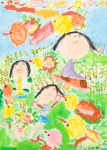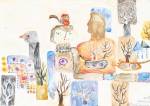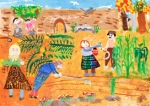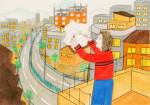Fajr International Theater Festival (FITF) is a golden opportunity to enjoy theatre projects from other cultural backgrounds. This year over 300 plays from Japanese, Hungarian, Spanish, German, Norwegian, Polish, French as well as Iranian artists were presented on all theater stages as well as some outdoor public spaces in Tehran.
The members of the jury panel for the international section – Stefan Schmid from Germany, Jerzy Limon from Poland, Oleg Loevski from Russia and Iranians Masoud Delkhah and Farrindokht Zahedi – honored “Hamlet” with two awards; German director Thomas Ostermeier received the Grand Prix of the festival and Lars Eidinger won the Best Actor Award. The play had three completely sold-out performances.

34th Fajr International Theater Festival in Iran – Hamlet – Germany

34th Fajr International Theater Festival in Iran – Hamlet – Germany
Photos: “Hamlet” directed by Thomas Ostermeier, Germany
Norway participated with a powerful performance of Henrik Ibsen’s “Hedda Gabler” by Visjoner Teater, founded by Juni Dahr in 1988. The play was staged at a house and not at a theatre to allow the site specific artistic concept of this production. The shows were sold out, thus an extra performance was organized. Actress and artistic director Juni Dahr won in 2014 the Jury’s FITF Special Prize for “Ibsen Women”.

34th Fajr International Theater Festival in Iran – Hedda Gabler – Norway

34th Fajr International Theater Festival in Iran – Hedda Gabler – Norway

34th Fajr International Theater Festival in Iran – Hedda Gabler – Norway

34th Fajr International Theater Festival in Iran – Hedda Gabler – Norway

34th Fajr International Theater Festival in Iran – Hedda Gabler – Norway
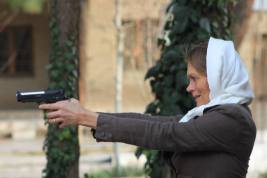
34th Fajr International Theater Festival in Iran – Hedda Gabler – Norway

34th Fajr International Theater Festival in Iran – Hedda Gabler – Norway
Photos: “Hedda Gabler” by Visjoner Teater, Norway
“The Shadow Game” written by Koichiro Iizuka and directed by Tatsuya Hasegawa from Japan’s Dazzle Dance Company took the stages by storm with four sold out shows at Tehran’s Vahdat Hall, leaving the audience breathless long after the actors have left the stage.
The play, about the clash between positive and negative energy to highlight the effects of the natural disasters in Japan, used a magnificent combination of street dance, electronic music, theater, elements of video games and anime plot with Japanese commentary all wrapped up in street and contemporary dance styles choreographed by Hasegawa himself. In 2012 Hasegawa’s “Misty Mansion” won the FITF Best Play Award.

34th Fajr International Theater Festival in Iran – The Shadow Game – Japan

34th Fajr International Theater Festival in Iran – The Shadow Game – Japan

34th Fajr International Theater Festival in Iran – The Shadow Game – Japan

34th Fajr International Theater Festival in Iran – The Shadow Game – Japan
Photos: “The Shadow Game” directed by Tatsuya Hasegawa, Japan
Hungary’s “Becoming Butterfly – Conspiracy” written and directed by Zsófia Bérczi, has taken the audience through an existential journey on the wings of imagination and visual aesthetics. There was something universal and deep about the play that made it connect with the audience no matter from which country and culture. “Human beings are not the most beautiful creation on earth, but they are the most beautiful dream of all creations on earth.” Bérczi also staged Living Surface at this year’s festival.

34th Fajr International Theater Festival in Iran – Living Surface – Hungary

34th Fajr International Theater Festival in Iran – Living Surface – Hungary

34th Fajr International Theater Festival in Iran – Living Surface – Hungary
Photos: “Living Surface” and “Becoming a Butterfly – Conspiracy” directed by Zsófia Bérczi, Hungary
“Peregrinus” from Poland’s KTO Theater is a performance without dialogue, illustrated by music that depicts a single day in the life of an individual of the 21st century. The contemporary “Everyman”, whose life is “suspended” between home and work for a corporation, identifies his or her “pathway through life” as a “pathway to work”. Homo Peregrinus is a formatted human being, stripped of emotionality, predictable and bereft of individual characteristics. Perigrinus’s belongings can be packed in one piece of hand luggage.

34th Fajr International Theater Festival in Iran – Peregrinus – Poland

34th Fajr International Theater Festival in Iran – Peregrinus – Poland

34th Fajr International Theater Festival in Iran – Peregrinus – Poland

34th Fajr International Theater Festival in Iran – Peregrinus – Poland

34th Fajr International Theater Festival in Iran – Peregrinus – Poland

34th Fajr International Theater Festival in Iran – Peregrinus – Poland

34th Fajr International Theater Festival in Iran – Peregrinus – Poland

34th Fajr International Theater Festival in Iran – Peregrinus – Poland
Photos: “Peregrinus” from KTO Theater, Poland
“Katastrophe” and “A House in Asia” were presented by Agrupación Serrano, a Spanish theatre company that creates original productions based on stories drawn from contemporary times, blending stage performance, text, video, sound, and scale models to stage stories about discordant aspects of today’s human experience.
The FITF international section also included “Dance of Death B La La”, a joint Iranian-German production by Iranian director Yaser Khaseb from Crazy Body Group, “Body Revolution” by Belgium based Iraqi director Mokhallad Rasem, the monologue “Monsters” by Laurent Fraunie from France, Georgian “Me-Medea” written and directed by Salome Joglidze and more.

34th Fajr International Theater Festival in Iran – Body Revolution – Belgium

34th Fajr International Theater Festival in Iran – Me-Medea – Georgia

34th Fajr International Theater Festival in Iran – Monster – France

34th Fajr International Theater Festival in Iran – Dance of Death B La La – Iran-Germany

34th Fajr International Theater Festival in Iran – Dance of Death B La La – Iran-Germany

34th Fajr International Theater Festival in Iran – Dance of Death B La La – Iran-Germany

34th Fajr International Theater Festival in Iran – Dance of Death B La La – Iran-Germany

34th Fajr International Theater Festival in Iran – Dance of Death B La La – Iran-Germany
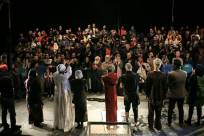
34th Fajr International Theater Festival in Iran – Dance of Death B La La – Iran-Germany
Photos: 34th Fajr International Theater Festival in Iran
Sources: Mehr News Agency (MNA) 1, MNA 2, MNA 3, MNA 4, Tehran Times 1, Tehran Times 2, srserrano.com, na-weekly.com, fitf.theater.ir, tiwall.com | 34th FITF (in Persian), tiwall.com | Dance of Death B La La (in Persian), teatrktro.pl, Honar Online, swr.de, Facebook | Visjoner Teater, Instagram @crazybodygroup, IRNA, Facebook | Teatr KTO


























































































